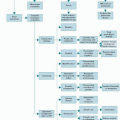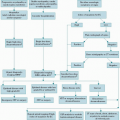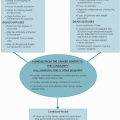Diarrhea is generally defined as the frequent passage of loose stools with urgency, commonly more than three unformed stools in 24 hours (
1). Diarrhea is a common and significant problem among patients with cancer, occurring in 5% to 10% of patients with advanced disease, and is seen as a major treatment complication in patients receiving chemotherapy, particularly with some agents (
2). Women are more likely to have diarrhea than men after excluding gender-specific cancers (
3). Diarrhea is also included among the top 10 consequences of adverse drug reactions in hospitalized patients with cancer (
4). The consequences of diarrhea can be troublesome and include loss of water, electrolytes, and albumin, failure to reach nutritional goals, declining immune function, and the risk of bedsores or systemic infection. Diarrhea also brings additional work for the nursing staff or family who have to prevent maceration and bedsores. Moreover, losses of comfort and dignity have to be considered. Severe diarrhea, other than being debilitating, is a costly complication of chemotherapy in colorectal cancer (
5). The median length of hospital stay due to diarrhea was 8 days, translating to a mean cost of $8,230 per patient (
6).
Although a practical definition is lacking, diarrhea is commonly diagnosed when an abnormal increase in daily stool weight, water content, and frequency, whether or not accompanied by urgency, perianal discomfort, or incontinence, is present as a consequence of incomplete absorption of electrolytes and water from luminal content.
Mechanisms
From the physiopathologic point of view, different mechanisms may produce diarrhea, although it is quite difficult in certain clinical conditions to distinguish among mechanisms that frequently overlap.
Osmotic Diarrhea
The ingestion of a poorly absorbable solute modifies the osmolarity of the luminal content and induces osmotic diarrhea. The proximal small bowel is highly permeable to water; sodium and water influx across the duodenum rapidly adjusts the osmolarity of luminal fluid toward that of plasma, secreting water even after the osmolarity values between luminal contents and plasma are similar. On the contrary, the mucosa of the ileum and colon has a low permeability to sodium and solutes. However, there is an efficient active ion transport mechanism that allows the reabsorption of electrolytes and water even against electrochemical gradients.
Excessive doses of laxatives or magnesium-containing antacids commonly result in diarrhea. When large amounts of lactulose, an unabsorbable sugar in the small intestine, are ingested, the protective role of colonic bacteria may be exhausted, producing diarrhea proportional to the osmotic force of the malabsorbed saccharide (
7). It is characterized by an osmotic gap in stool analysis equivalent to the concentration of the osmotically active agents in fecal fluid that cause diarrhea. Similarly, carbohydrate malabsorption may induce osmotic diarrhea, which is characterized by a low stool pH, because of the presence of short-chain fatty acids, a high content of carbohydrates, a high stool osmolarity, and flatulence. Moreover, reversible chemotherapy-related hypolactasia and lactose intolerance are not infrequent in patients treated with 5-fluorouracil (5-FU)-based adjuvant chemotherapy for colorectal cancer. Avoidance of lactose during chemotherapy may improve treatment tolerability in these patients (
8).
The ingestion of other substances, such as magnesium, sulfate, and poorly absorbed salts may produce osmotic diarrhea. However, there will be a normal pH, unlike in carbohydrate-induced diarrhea. In the perioperative period, massive antibiotic therapy is able to suppress normal colonic metabolism, thereby resulting in diarrhea (
7). Osmotic diarrhea commonly subsides as the patient discontinues the poorly absorbable agents.
Secretory Diarrhea
Secretory diarrhea is rarely present as the sole mechanism and is often associated with other mechanisms (
7). This kind of diarrhea is associated with an abnormal ion transport in intestinal epithelial cells, with a reduction in absorptive function or increase in the secretion of epithelial cells. Unlike in osmotic diarrhea, the anionic gap is small and eating does not markedly increase stool volume. Moreover, diarrhea usually persists despite fasting.
Many factors may affect ion transport in the epithelial cells of the gut. These include bacterial toxins, intraluminal secretagogues (such as bile acids or laxatives), or circulating secretagogues (such as various hormones, drugs, and poisons). Moreover, other medical problems that compromise regulation of intestinal function or reduce absorptive surface area (by disease or resection) can induce secretory diarrhea (
9).
Endocrine tumors may cause diarrhea through the release of secretagogue transmitters (
10). Diarrhea is a common manifestation of a carcinoid syndrome, occurring in approximately 70% of patients, and seems to be mediated by the release of serotonin and substance P. In the Zollinger-Ellison syndrome, secretory diarrhea is the consequence of gastric hypersecretion caused by a high concentration of circulating gastrin, overwhelming the intestinal absorptive capacity. In a medullary carcinoma of the thyroid, circulating calcitonin is the major mediator of intestinal secretion (
11).
Malabsorption due to different mechanisms may equally produce diarrhea (see Section Malabsorption).
Cancer treatment-related diarrhea is the most known and is caused by chemotherapeutic agents such as fluoropyrimidines, taxanes, capecitabine, and irinotecan (
6), and graft-versus-host disease (GVHD) (
12) and targeted therapy significantly affect morbidity and mortality. Diarrhea is a significant consequence of colorectal chemotherapy, with most patients experiencing grade 3 or 4 diarrhea (
13). Patients who experienced chemotherapy-induced diarrhea underwent changes in their regimen, including dose reductions, delays in therapy, reduction in dose intensity, and discontinuation of therapy (
2). These agents cause acute and chronic damage to the intestinal mucosa, necrosis, and extensive inflammation of the bowel wall. Mucosal and submucosal factors, produced directly or indirectly by the inflamed intestine, stimulate secretion of intestinal fluid and electrolytes. Similar anatomic changes have been observed in patients with GVHD-induced diarrhea, as well as with radiation enteritis (
14). The toxicity grades of these agents seem to depend on individual genotypes (
15); 53% of patients treated with concurrent pelvic radiation therapy and fluorouracil develop diarrhea (
16). The severity of diarrhea is correlated with the volume of small bowel receiving at least 15 Gy of radiation (
17). Chronic radiation enteritis is less common and is usually associated with radiation doses >45 Gy. In this case, the underlying pathology is an endoarteritis that causes intestinal ischemia (
13).
On the other hand, intestinal mucositis also increases the risk of superinfection by opportunistic pathogens such as
Clostridium difficile,
Clostridium perfringens,
Bacillus cereus,
Giardia lamblia,
Cryptosporidium,
Salmonella,
Shigella,
Campylobacter, and
Rotavirus, particularly in patients who may be neutropenic or immunosuppressed. Bacterial enterotoxins or other infective agents induce secretion probably by a local nervous reflex mediated by enteroendocrine cells or inflammation (
1). The incidence of
C. difficile-induced diarrhea is very high—2.2% in patients receiving standard-dose regimens and 20% in patients receiving high-dose regimens (
18).
The use of long-term antibiotics is also associated with diarrhea in patients who recently underwent surgery or are immunocompromised. Agents more frequently causing diarrhea include ampicillin, clindamycin, or cephalosporins, because of the disruption of the normal flora and facilitation of the overgrowth of pathogens.
C. difficile, an anaerobic organism producing an enteric toxin, induces pseudomembranous enterocolitis, which presents as a severe microbial diarrhea. Other infectious agents include
C. perfringens, Staphylococcus aureus, Klebsiella oxytoca,
Candida species, and
Salmonella species (
19).
Diarrhea induced by enteral feeding is via nasogastric tube or gastroenterostomies. It is a common problem that is observable in 10% to 60% of patients. Formula osmolarity, rate of delivery, and contamination are determinants (
13). Finally, many drugs may cause diarrhea. Diuretics, caffeine, theophylline, antacids, antibiotics, and poorly absorbable laxative agents and osmotically active solutes, often chronically administered in a palliative care setting, likely produce reflex nervous secretion or directly activate secretory cellular mechanism (
1).
Deranged Motility
Deranged motility may reduce the contact time between luminal contents and epithelial cells. This commonly occurs in patients with cancer with postsurgical disorders, such as postgastrectomy dumping syndrome, postvagotomy, ileocecal valve resection, or neoplastic and chronic diseases such as malignant carcinoid syndrome, medullary carcinoma of the thyroid, and diabetes. The mechanism by which diabetic neuropathy causes dysmotility is attributed to a sympathetic denervation of the bowel with a prevalence of cholinergic innervation (
19). Similarly, procedures such as celiac plexus block produce a sympathetic denervation of the bowel, which may leave a cholinergic innervation unopposed, leading to an increase in intestinal motility and diarrhea, until adaptation mechanisms develop (
13).
Spinal cord damage may reduce intestinal mobility favoring bacterial overgrowth, which induces a deconjugation of bile acids in the small bowel and thereby causes diarrhea and steatorrhea. Diarrhea secondary to dysmotility disorders commonly subsides after a 1 to 2-day fast, determining a small stool volume and an osmolality in the range of 250 to 300 mOsm.
Assessment
The assessment includes a detailed medical history, dietary history, previous surgery, medication review, physical examination, and description of stools. Frequency, amounts, and consistency of the stools should be carefully obtained. When the stools are consistently large, light in color, watery or greasy, free of blood, or contain undigested food particles, the underlying disorder is likely to be in the small bowel or the proximal colon. Indeed, small stool diarrhea, in which frequent but small quantities of feces that are dark in color and often contain mucus or blood pass in spite of a sense of urgency, is associated with a disorder of the left colon or rectum (
1,
13). Widespread inflammation may simultaneously produce both patterns of diarrhea, confirmed by the passage of nonbloody diarrheal fluid, pus, or exudates. Other useful information includes fecal incontinence, change in stool caliber, rectal bleeding, and small, frequent, but otherwise normal stools.
Timing and spontaneous recovery are also important. Although osmotic diarrhea typically stops or reduces after fasting or stopping the drug previously used, secretory diarrhea persists in spite of fasting. Chemotherapy-induced diarrhea typically occurs 2 to 14 days after therapy. Radiation colitis is probable in patients who have recently received pelvic radiation for malignancies of the urogenital tract and of the prostate.
A physical examination should precede any further investigation. Signs of anemia, fever, postural hypotension, lymphadenopathy, neuropathy, hepatosplenomegaly, ascites, gaseous abdominal distention or lymphadenopathy, reduced anal sphincter tone, a rectal mass or impaction, and deterioration of nutritional status are of paramount importance in defining the type of diarrhea. Some etiologies may have a typical clinical pattern. For example, carbohydrate malabsorption is typically associated with excessive flatus and mushy stools, whereas intermittent diarrhea and constipation are frequent in diabetic neuropathy, as well as in irritable bowel syndrome or subobstructive disorders. Autonomic neuropathy or anal sphincter dysfunction may be characterized by nocturnal diarrhea and fecal soiling. Alternating diarrhea and constipation suggests fixed colonic obstruction. Fecal impaction may cause apparent diarrhea because only liquids pass a partial obstruction. Symptoms of dumping syndrome after gastric surgery, such as early nausea, abdominal distention, weakness, and diarrhea after a meal followed by hypoglycemia, sweating, dizziness, and tachycardia, are typical. Secretory diarrhea combined with upper GI symptoms caused by refractory peptic ulcer disease is suggestive of a gastrin-secreting tumor. High circulating serotonin levels in carcinoid syndrome cause other effects besides diarrhea, including hypotension, sweating, flushing, palpitation, and wheeziness (
19). The association of heat intolerance, palpitations, and weight loss suggests possible hyperthyroidism. Intestinal dysmotility or bacterial overgrowth due to diabetes, neoplastic conditions, or postoperative conditions should be suspected, excluding other causes.
Chronic bowel ischemia should be considered in elderly patients with the clinical features of diffuse atherosclerotic disease. Rectal examination and abdominal palpation should be performed to look for fecal masses and to exclude fecal impaction and intestinal obstruction, as well as for perianal fistula or abscess. Rectal involvement is probable in the presence of tenesmus, commonly defined as the passing of a little or no stool in spite of a sense of rectal urgency.
Of course, the site of neoplasm and metastases is of paramount importance. An abdominal x-ray will help the diagnosis. The location of the tumor will be verified by computed tomography scan, magnetic resonance imaging, angiography, or laparoscopy.
Laboratory findings should complete the investigation. If feasible, collected diarrhea stool specimen should be submitted for qualitative study. A positive finding in either the stool guaiac or the leukocyte test leads to a suspicion of an exudative mechanism, as in radiation colitis, colonic neoplasm, or infective diarrhea. Stool cultures for bacterial, fungal, and viral pathogens, as well as a formal evaluation of the GI tract, should complete the initial assessment (
14). Gram stain of the stool can diagnose the presence of
Staphylococcus, Campylobacter, or
Candida infection. Multiple stool cultures should be obtained from patients with secretory diarrhea to rule out microorganisms producing enterotoxins that stimulate intestinal secretion. The presence of a microorganism in the stools is diagnostic.
An anionic gap of >50 mmol/L due to a reduction of stool content in sodium and potassium suggests an osmotic diarrhea, whereas lower values (<50 mmol/L) indicate a secretory diarrhea due to active secretion of salts and water.








